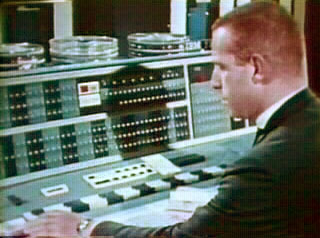|
Mobile Digital Computer
Sylvania Electric Products, Sylvania's MOBIDIC, short for "MOBIle DIgital Computer", was a Transistor computer, transistorized computer intended to store, sort and route information as one part of the United States Army's Fieldata concept. Fieldata aimed to automate the distribution of battlefield data in any form, ensuring the delivery of reports to the proper recipients regardless of the physical form they were sent or received. MOBIDIC was mounted in the trailer of a semi-trailer truck, while a second supplied power, allowing it to be moved about the battlefield. The Army referred to the system as the AN/MYK-1, or AN/MYK-2 for the dual-CPU version, Sylvania later offered a commercial version as the S 9400. History In early 1956 the Army Signal Corps at Fort Monmouth released a contract tender for the development of a van-mounted mobile computer as part of their Fieldata efforts. Fieldata envisioned a system where any sort of reports would be converted into text format and then ... [...More Info...] [...Related Items...] OR: [Wikipedia] [Google] [Baidu] |
Sylvania Electric Products
Sylvania Electric Products Inc. was an American manufacturer of diverse electrical equipment, including at various times radio transceivers, vacuum tubes, semiconductors, and mainframe computers such as MOBIDIC. They were one of the companies involved in the development of the COBOL programming language. History The ''Hygrade Sylvania Corporation'' was formed when '' NILCO'', ''Sylvania'' and '' Hygrade Lamp Company'' merged into one company in 1931. In 1939, Hygrade Sylvania started preliminary research on fluorescent technology, and later that year, demonstrated the first linear, or tubular, fluorescent lamp. It was featured at the 1939 New York World's Fair. Sylvania was also a manufacturer of both vacuum tubes and transistors. In 1942, the company changed its name to Sylvania Electric Products Inc. During World War II, Sylvania was chosen from among several competing companies to manufacture the miniature vacuum tubes used in proximity fuze shells due to its quality s ... [...More Info...] [...Related Items...] OR: [Wikipedia] [Google] [Baidu] |
IBM 305 RAMAC
The IBM 305 RAMAC was the first commercial computer that used a moving-head hard disk drive (magnetic disk storage) for secondary storage. The system was publicly announced on September 14, 1956,650 RAMAC announcement The 305 RAMAC and the 650 RAMAC were internally announced on September 4, 1956. with test units already installed at the U.S. Navy and at private corporations. RAMAC stood for "Random Access Method of Accounting and Control", as its design was motivated by the need for real-time accounting in business.IBM RAMAC promotional film /ref> History RAMAC wa ...[...More Info...] [...Related Items...] OR: [Wikipedia] [Google] [Baidu] |
Input/output
In computing, input/output (I/O, i/o, or informally io or IO) is the communication between an information processing system, such as a computer, and the outside world, such as another computer system, peripherals, or a human operator. Inputs are the signals or data received by the system and outputs are the signals or data sent from it. The term can also be used as part of an action; to "perform I/O" is to perform an input or output operation. are the pieces of hardware used by a human (or other system) to communicate with a computer. For instance, a keyboard or computer mouse is an input device for a computer, while monitors and printers are output devices. Devices for communication between computers, such as modems and network cards, typically perform both input and output operations. Any interaction with the system by an interactor is an input and the reaction the system responds is called the output. The designation of a device as either input or output depend ... [...More Info...] [...Related Items...] OR: [Wikipedia] [Google] [Baidu] |
Real-time Computing
Real-time computing (RTC) is the computer science term for Computer hardware, hardware and software systems subject to a "real-time constraint", for example from Event (synchronization primitive), event to Event (computing), system response. Real-time programs must guarantee response within specified time constraints, often referred to as "deadlines".Mordechai Ben-Ari, Ben-Ari, Mordechai; "Principles of Concurrent and Distributed Programming", ch. 16, Prentice Hall, 1990, , p. 164 The term "real-time" is also used in Computer simulation, simulation to mean that the simulation's clock runs at the same speed as a real clock. Real-time responses are often understood to be in the order of milliseconds, and sometimes microseconds. A system not specified as operating in real time cannot usually ''guarantee'' a response within any timeframe, although ''typical'' or ''expected'' response times may be given. Real-time processing ''fails'' if not completed within a specified deadline rela ... [...More Info...] [...Related Items...] OR: [Wikipedia] [Google] [Baidu] |
Sylvania MOBIDIC Model (2585216399)
Sylvania (Latin for "forest land" or "woods") may refer to: Companies trading as Sylvania * Sylvania Electric Products, a former major American diversified electrical and electronics manufacturer * Sylvania (brand), its Canadian lighting products division which continues to license to both Havells Sylvania and Osram Sylvania * Osram Sylvania, an American lighting manufacturer owned by Osram AG of Germany * Sylvania Lighting, an international lighting manufacturer owned by Shanghai Feilo Acoustics Ltd Education * Sylvania City School District, in Northwest Ohio, United States * Sylvania High School, in Sydney, New South Wales, Australia Places United States * Sylvania, Alabama * Sylvania, Arkansas * Sylvania, Georgia * Sylvania, Indiana * Sylvania, Louisville, Kentucky * Sylvania, Missouri * Sylvania, Ohio * Sylvania, Pennsylvania * Sylvania, Wisconsin * Mount Sylvania, in Oregon * Sylvania Mountains, in California and Nevada * Sylvania Township (disambigua ... [...More Info...] [...Related Items...] OR: [Wikipedia] [Google] [Baidu] |
General Telephone
GTE Corporation, formerly General Telephone & Electronics Corporation (1955–1982), was the largest independent telephone company in the United States during the days of the Bell System. The company operated from 1926, with roots tracing further back than that, until 2000, when it was acquired by Bell Atlantic, which changed its name to Verizon. The Wisconsin-based Associated Telephone Utilities Company was founded in 1926; it went bankrupt in 1933 during the Great Depression, and was reorganized as General Telephone in 1934. In 1991, it acquired the third largest independent, Continental Telephone (ConTel). It owned Automatic Electric, a telephone equipment supplier similar in many ways to Western Electric, and Sylvania Lighting, the only non-communications-oriented company under GTE ownership. GTE provided local telephone service to many areas of the U.S. through operating companies, much as American Telephone & Telegraph provided local telephone service through its 22 ... [...More Info...] [...Related Items...] OR: [Wikipedia] [Google] [Baidu] |
The Pentagon
The Pentagon is the headquarters building of the United States Department of Defense, in Arlington County, Virginia, across the Potomac River from Washington, D.C. The building was constructed on an accelerated schedule during World War II. As a symbol of the United States Armed Forces, U.S. military, the phrase ''The Pentagon'' is often used as a metonym for the Department of Defense and its leadership. The building was designed by American architect George Bergstrom and built by contractor John McShain. Ground was broken on 11 September 1941, and the building was dedicated on 15 January 1943. General Brehon Somervell provided the major impetus to gain Congressional approval for the project. Colonel Leslie Groves was responsible for overseeing the project for the United States Army Corps of Engineers, U.S. Army Corps of Engineers, which supervised it. The Pentagon is List of largest office buildings, the world's second-largest office building, with about of floor space, of ... [...More Info...] [...Related Items...] OR: [Wikipedia] [Google] [Baidu] |
BMEWS
The RCA 474L Ballistic Missile Early Warning System (BMEWS, 474L System, Project 474L) was a United States Air Force Cold War early warning radar, computer, and communications system, for ballistic missile detection. The network of twelve radars, which was constructed beginning in 1958 and became operational in 1961, was built to detect a mass ballistic missile attack launched on northern approaches [for] 15 to 25 minutes' warning time also provided Project Space Track satellite data (e.g., about one-quarter of Space Detection and Tracking System, SPADATS observations). It was replaced by the Solid State Phased Array Radar System in 2001. Background The Ballistic Missile Early Warning System (BMEWS) was a radar system built by the United States (with the cooperation of Canada and Denmark on whose territory some of the radars were sited) during the Cold War The Cold War was a period of global Geopolitics, geopolitical rivalry between the United States (US) and the Sovie ... [...More Info...] [...Related Items...] OR: [Wikipedia] [Google] [Baidu] |
IBM 7090
The IBM 7090 is a second-generation Transistor computer, transistorized version of the earlier IBM 709 vacuum tube mainframe computer that was designed for "large-scale scientific and technological applications". The 7090 is the fourth member of the IBM 700/7000 series#Scientific Architecture, IBM 700/7000 series scientific computers. The first 7090 installation was in December 1959. In 1960, a typical system sold for $2.9 million (equivalent to $ million in ) or could be rented for $63,500 a month (). The 7090 uses a 36-bit word length, with an address space of 32,768 words (15-bit addresses). It operates with a basic memory cycle of 2.18 μs, using the IBM 7302 Core Storage Magnetic-core memory, core memory technology from the IBM 7030 (Stretch) project. With a processing speed of around 100 FLOPS, Kflop/s, the 7090 is six times faster than the 709, and could be rented for half the price. An upgraded version, the 7094, was up to twice as fast. Both the 7090 and the 7094 ... [...More Info...] [...Related Items...] OR: [Wikipedia] [Google] [Baidu] |
ELINT
Signals intelligence (SIGINT) is the act and field of intelligence-gathering by interception of ''signals'', whether communications between people (communications intelligence—abbreviated to COMINT) or from electronic signals not directly used in communication (electronic intelligence—abbreviated to ELINT). As classified and sensitive information is usually encrypted, signals intelligence may necessarily involve cryptanalysis (to decipher the messages). Traffic analysis—the study of who is signaling to whom and in what quantity—is also used to integrate information, and it may complement cryptanalysis. History Origins Electronic interceptions appeared as early as 1900, during the Boer War of 1899–1902. The British Royal Navy had installed wireless sets produced by Marconi on board their ships in the late 1890s, and the British Army used some limited wireless signalling. The Boers captured some wireless sets and used them to make vital transmissions. Since the ... [...More Info...] [...Related Items...] OR: [Wikipedia] [Google] [Baidu] |
Boeing RC-135
The Boeing RC-135 is a family of large reconnaissance aircraft built by Boeing and modified by a number of companies, including General Dynamics, Lockheed, LTV, E-Systems, L3Harris Technologies, and used by the United States Air Force and Royal Air Force to produce theater and national level intelligence with near real-time on-scene collection, analysis and dissemination capabilities. Based on the C-135 Stratolifter airframe, various types of RC-135s have been in service since 1961. Unlike the C-135 and KC-135 which are recognized by Boeing as the Model 717, most of the current RC-135 fleet, with the exception of the RAF's RC-135Ws, is internally designated as the Model 739 by the company. Many variants have been modified numerous times, resulting in a large variety of designations, configurations, and program names. Design and development In 1962, the first RC-135 variant, the RC-135A, was ordered by the United States Air Force to replace the Boeing RB-50 Superfortres ... [...More Info...] [...Related Items...] OR: [Wikipedia] [Google] [Baidu] |







